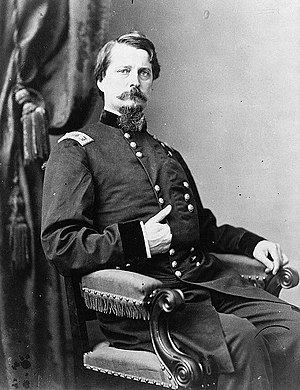In the end of September, 1864, Ulysses S. Grant launched several attacks against Lee's lines around Richmond and Petersburg. One of these, conducted on the eastern end of the line by Benjamin Butler, captured Fort Harrison and New Market Heights on September 29th. Lee sent I Corps commander Richard Anderson to the scene to contain the breakthrough. Anderson launched several unsuccessful counterattacks to try to recapture the Confederate line. Grant rightly believed that these attacks were being made by troops from Lee's right, so he ordered Gouverneur Warren to attack on that portion of the line with the V Corps.
 |
| Warren |
Warren's troops begin moving on September 30th, striking A. P. Hill's Third Corps, which had indeed been weakened to reinforce the Confederate left. The Federals attacked at 1 pm and quickly broke the Confederate line, capturing Fort Archer while the southerners fled to the rear. When Lee realized that his right also was in critical danger, he recalled the Light Division and sent them back to the right. The IX Corps had been brought up to support the Union line, which Warren thought would face a counterattack. That Corps was not properly connected to the V Corps. When Heth's men attacked at 4:30 pm, they routed the IX Corps, capturing nearly an entire brigade. Warren rallied his men, and the fighting died down for the day.
 |
| Heth |
On October 1st Heth again attacked Warren's line, but this time the assaults were repulsed. The next day Warren was reinforced with a division from the II Corps, which led an attack on the Confederate works. Their goal was the Boydton Plank Road, an important Confederate supply route. This attack overran Confederate positions, but was stopped before reading the road. Although this battle had no decisive impact on the campaign, it did lengthen the lines further clockwise around Petersburg, bringing Grant closer to cutting off Lee's line of communication. In this fight the Union lost almost 2,900, the Confederates over 1,200.

